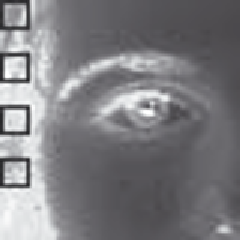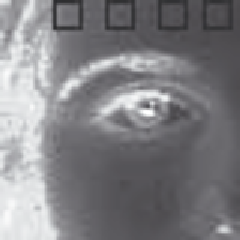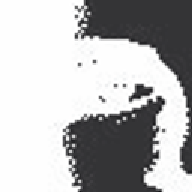Image Processing Reference
In-Depth Information
(a) Hair
(b) Skin
Figure 8.6
Training regions for classification
(a) Convolved
(b) Tiled
(c) Thresholded
Figure 8.7
Segmenting the eye image into two classes
shown in Figure
8.7
(b). The resolution is clearly very poor: the image has effectively been
reduced to a set of 7 × 7 regions but it is much
faster
, requiring only 2% of the computation
of the convolution approach.
A comparison with the result achieved by uniform thresholding is given, for comparison,
in Figure
8.7
(c). This is equivalent to pixel segmentation by brightness alone. Clearly, there
are no regions where the hair and skin are mixed and in some ways the result appears
superior. This is in part due to the simplicity in implementation of texture segmentation.
But the result of thresholding depends on
illumination
level and on appropriate choice of
the threshold value. The texture segmentation method is completely
automatic
and the
measures are known to have
invariance
properties to illumination, as well as other factors.
Also, in uniform thresholding there is no extension possible to separate
more
classes
(except perhaps to threshold at differing brightness levels).
8.6
Further reading
Clearly, there is much further reading in the area of texture description, segmentation, and
classification as evidenced by the volume of published work in this area. There is one fairly





















